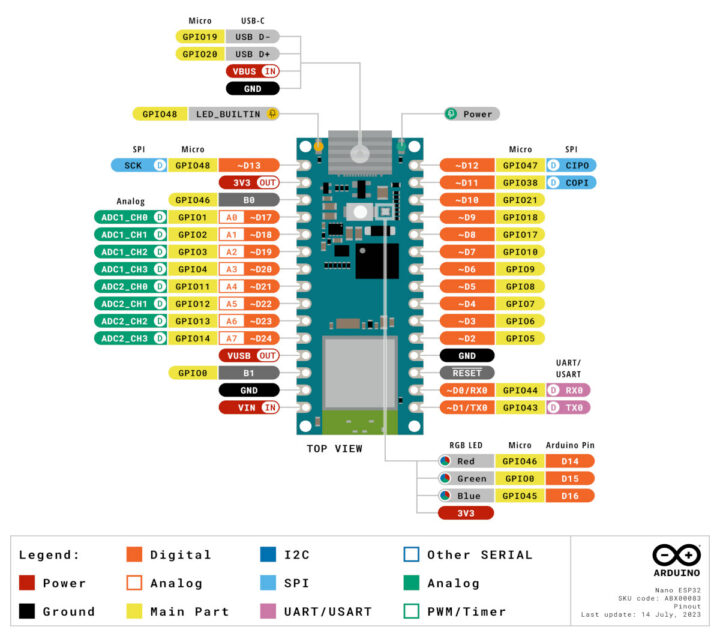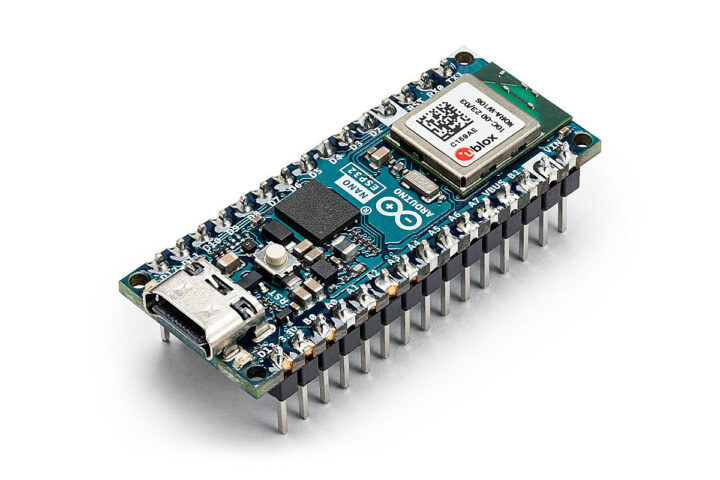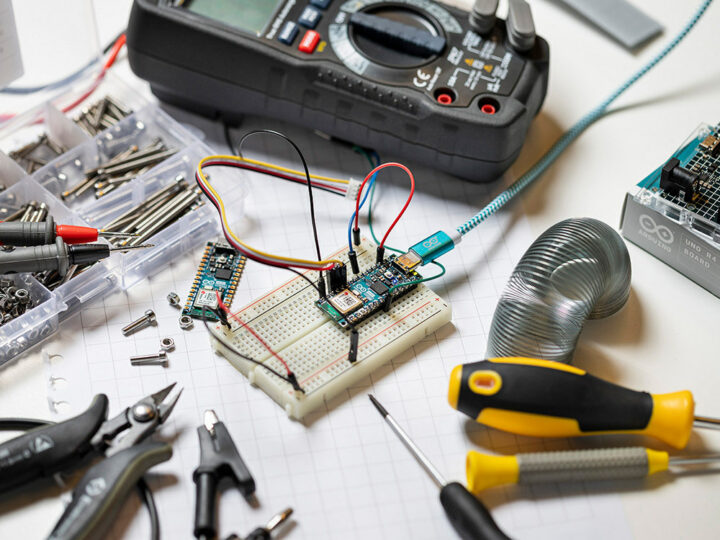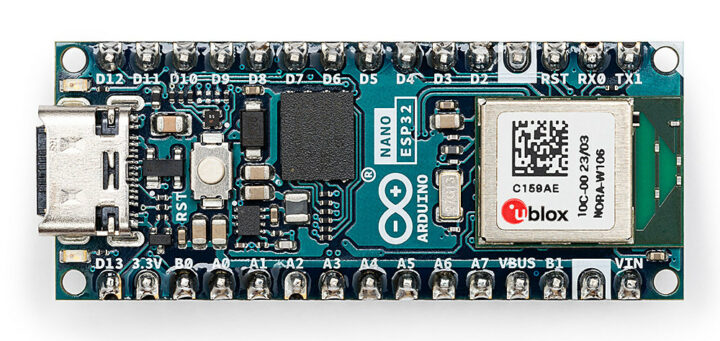The Arduino Nano ESP32 is an ESP32-S3-based WiFi and Bluetooth microcontroller board designed for IoT applications for hobbyists and enterprise use cases. The new Nano board comes with 8 MB PSRAM and 16 MB flash storage and can be programmed with either the Arduino or MicroPython languages.
It’s not the first ESP32 board from Arduino, as the Nano RP2040 Connect pairs a Raspberry Pi RP2040 MCU with an ESP32 module from u-Blox and the just-released Arduino UNO R4 WiFi marries a Renesas RA4M1 Arm Cortex-M33 MCU with an ESP32-S3-MINI-1 module. But the Arduino Nano ESP32 is different since it’s the first ESP32 board from Arduino where the Espressif chip is the only microcontroller onboard and handles both wireless connectivity and GPIOs.
Arduino Nano ESP32 specifications:
- Wireless module – u-Blox NORA-W106-10B with
- MCU – ESP32-S3 dual-core Xtensa LX7 microcontroller @ up to 240 MHz with vector extensions, 512KB SRAM, 384KB ROM, WiFi 4 and Bluetooth 5.0 connectivity
- Memory – 8MB PSRAM
- Embedded PCB antenna
- Dimensions – 14.3 x 10.4 x 1.8 mm
- Storage – 16MB flash
- USB – 1x USB Type-C port for power and programming
- I/Os
- 2x 15-pin expansion headers with 14x GPIOs, 13x LED pins, 5x PWM, 8x analog inputs, 2x UART, 1x I2C, 1x SPI, reset, and power signals (+5V, +3.3V, GND, Vin, AREF, …)
- 3.3V I/O (not 5V tolerant)
- Source current per I/O pin – 40 mA
- Sink current per I/O pin – 28 mA
- Misc – Reset button, and 2x LEDs
- Power Supply
- 5V via USB
- 6-21V via Vin pin on headers
- Dimensions – 45 x 18 mm compatible with the original Arduino Nano
- SKUs – ABX00083 with headers, ABX00092 without headers

The Arduino Nano ESP32 supports both MicroPython and Arduino programming languages, and the company provides a MicroPython 101 course using the Arduino Lab for MicroPython. The board also easily integrates into the Arduino IoT Cloud. More technical details and instructions to get started can be found in the documentation.
The Arduino Nano ESP32 is now available for $20 and $21 on the company’s store without or with headers respectively. As usual, Arduino also has pricing for the European market for 18 Euros and 19 Euros respectively.
Update: This post was initially published on July 17, and updated with further details once the documentation and product pages were made available.

Jean-Luc started CNX Software in 2010 as a part-time endeavor, before quitting his job as a software engineering manager, and starting to write daily news, and reviews full time later in 2011.
Support CNX Software! Donate via cryptocurrencies, become a Patron on Patreon, or purchase goods on Amazon or Aliexpress. We also use affiliate links in articles to earn commissions if you make a purchase after clicking on those links.







How does this board compare to the Lolin S3, which is the first related post?
Since that one even seems to expose UART through a USB C, whereas this one benefits from Arduino support.
On the hardware front, I don’t see that many differences, except the Lolin S3 has a few more I/Os and a USB-C OTG port.
The Arduino Nano ESP32 benefits from official support for the Arduino IDE and Arduino Labs for MicroPython, a larger community, and helps sponsor software development.
Now that the documentation for the Nano ESP32 has been released, one advantage is the Vin input that supports 6V to 21V.
What does the u-Blox NORA-W106-10B offer vs the normal ESP32-S3?
I was wondering the same. Esp has internal wifi. It’s kind of their thing.
Is that why the board is twice the price of the Lolin board mentioned in related links? I don’t get it. (Which probably just means that I, a hobbyist developer that collects SBCs, am not their target market and it’s not for me.. even.though I am passively looking for a couple of S3 boards right now.)
The u-Blox NORA-W106-10B has no internal flash and 8 MB internal PSRAM.
Arduino Nano ESP32 has a 16MB external flash.
There’s only one ESP32 on the board, it’s in the u-Blox module. The specs are indented, or does it not show that way on smaller displays?
The block diagram just shows an ESP32-S3 with a PCB antenna. Arduino seems to have a business relationship with u-Blox as all the (new) Arduino boards with wireless are based on u-Blox modules, and they may be getting good support from them.
So its just a normal esp with an antenna in a metal package then?
Yes, I’m unable to find other differences, so that’s why I think it’s about support and/or possibly procurement.
Does this board support ESP32-NOW protocol for WiFi pier-to-pier communication without the need to access a wireless network?
There seems to be only ONE UART, not two.
You’re right, there’s only one in the block diagram… But the Arduino website lists two…